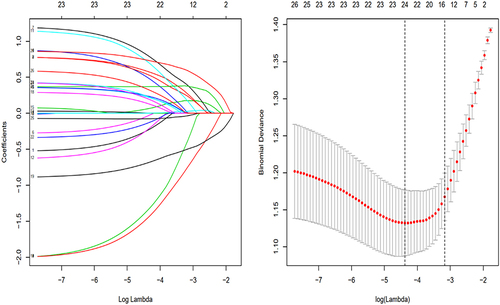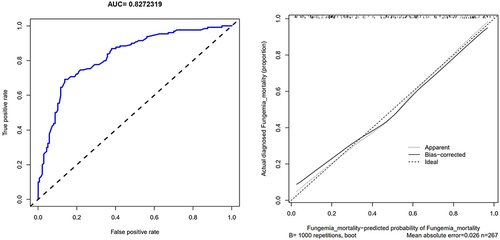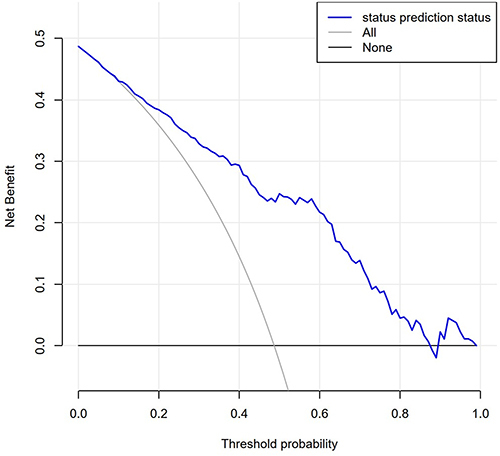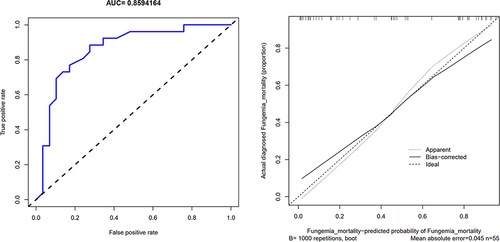Abstract
Background
Few predictive models have been established to predict the risk of 30-day mortality from fungemia. This study aims to create a nomogram to predict the 30-day mortality of fungemia in ICUs.
Methods
Data of ICU patients with fungemia from both the Medical Information Mart for Intensive Care (MIMIC-III) database and the Grade-III Class-A hospital in China were collected. The data extracted from the MIMIC-III database functioned as the training dataset, which was used to construct a predictive model for 30-day mortality risk in ICU patients with fungemia; the data from the hospital functioned as the validation dataset, which was used to validate the model. A predictive model for 30-day mortality risk in ICU patients with fungemia was then built based on R software. Such indicators as C-index and calibration curve were utilized to evaluate the prediction ability of the model. Data of ICU patients with fungemia from the hospital were used as a validation dataset to validate the model.
Results
Predictive models were constructed by age, international normalized ratio (INR), renal failure, liver disease, respiratory rate (RR), glucocorticoid therapy, antifungal therapy, and platelets. The C-index value of the models was 0.838 (95% CI: 0.79096–0.88504). Attested by external validation results, the model has satisfactory predictive ability.
Conclusion
The 30-day mortality risk predictive model for ICU patients with fungemia constructed in this study has good predictive ability and may hopefully provide a 30-day mortality risk screening tool for ICU patients with fungemia.
Keywords:
Introduction
Fungemia is a highly lethal disease, and Candida is the major pathogen.Citation1 Candidemia can be defined as the presence of any species of Candida in the blood.Citation2 Recently, due to the widespread use of active immunosuppressive therapy and increasing use of invasive devices, such as central venous catheters,Citation3 the incidence of intensive care unit admission (ICU admission) has increased significantly among patients with fungemia.Citation4 Candidemia is the fourth most common cause of nosocomial bloodstream infection (BSI) in the United States.Citation5 The meta-analysis by Koehler et alCitation6 shows that the highest pooled incidence rate is observed in ICUs (5.5/1000 admissions; 30-day mortality: 37%). Mortality rate of candidemia can be 35% to 80%,Citation7,Citation8 with prolonged hospital stay and increased treatment cost.Citation9,Citation10 Treatment cost increase may worsen doctor-patient relationships.Citation11 Therefore, accurate prediction of an illness and its mortality rate may improve both the prognosis and the relationship between doctors and patients.
Although there are many models, which can predict the possibility of candidemia,Citation12,Citation13 only few can predict the mortality of fungemia. This study aims to establish a simple model to predict the 30-day mortality of fungemia in ICUs by using the known clinical vital signs and laboratory physiological and biochemical variables of patients with positive blood cultures. The model may reduce uncertainty in clinical decision-making and help doctors and patients’ families to predict mortality.
Methods
Study Design
This retrospective study was based on the MIMIC-III Database.Citation14 The inclusion criteria were positive fungal blood cultures and age over 18 years old, while the exclusion criterion was incomplete data. This large open database consists of about 53,000 adult ICU patients’ de-identified health-related data from 2001 to 2012 at Beth Israel Deaconess Medical Center in Boston, MA. It was jointly established by Massachusetts Institute of Technology, Phillips Healthcare and Beth Israel Deaconess Medical Center. Access to and use of it were granted after “Human Research (Curriculum Group)”, a course of the Collaborative Institutional Training Initiative (CITI) Program, was finished (Certification Number: 29641289). Using database was subject to approval by the institutional review boards of Massachusetts Institute. Based on the Medical Information Mart for Intensive Care (MIMIC-III) database, which served as the training dataset to construct a 30-day mortality risk predictive model for ICU patients with fungemia. Data from ICU of a Grade-III Class-A hospital in China are selected as the validation dataset of the model. Ethics Committee of Nanchong Central hospital (Version No. 2021 Review (No. 103)) waived the need for written informed consent provided by participants due to the retrospective nature of this study and the study did not involve patient data disclosure. The authors confirm that the ethical policies of the journal, as noted on the journal’s author guidelines page, have been adhered to. This study complies with the Declaration of Helsinki.
Data Collection
The variables extracted from the MIMIC-III Database and a Grade-III Class-A hospital in China were age on the day of blood culture test, sex, and major underlying diseases, such as diabetes mellitus (diabetes), congestive heart failure (CHF), chronic obstructive pulmonary disease (COPD), renal failure, liver disease and solid tumors. The variables of blood test results were plasma albumin (albumin, g/dL), serum bilirubin (bilirubin, mg/dL), serum creatinine (creatinine, mg/dL), blood urea nitrogen (BUN, mg/dL), blood lactate (lactate, mmol/L), platelet count (platelet, /L), international normalized ratio (INR) and pulse oxygen saturation (SpO2) on the day of blood culture test. The variables of vital signs were heart rate (HR, beats/min), respiratory rate (RR, breaths/min), mean arterial pressure (MAP, mmHg) and temperature (Temp, °C) on the day of blood culture test. The severity of fungemia was estimated using the sequential organ failure assessment (SOFA) score on the day of blood culture test. The worst value of a variable was taken if repeated tests were done. Data about immunosuppressive agents, glucocorticoids, renal replacement therapy, antifungal therapy within 36 h of blood culture test and fungus types were extracted.
Statistical Analysis
The count data were expressed as case numbers (n). Shapiro–Wilk normality test showed that some data did not conform to a normal distribution (P<0.05). Therefore, the measurement data in this study were described asP50 (P25, P75). Analyses were performed using SPSS (IBM SPSS Statistics 25). Least absolute shrinkage and selection operator (LASSO) regression analysis and multivariable logistic regression analysis were conducted, and a nomogram was created with R software (Version 3.5.1).
Predictors were selected via LASSO with R software. Multivariable logistic regression analysis was performed to develop a predictive model for the 30-day ICU mortality of fungemia based on the predictors selected via LASSO. Odd ratios (ORs) demonstrate the correlations between these factors and mortality rate of fungemia. P values of less than 0.05 were considered to indicate statistical significance. The nomogram was created based on the results of multivariable analysis. The predictors whose P values were less than 0.05 were included.
The receiver operating characteristic (ROC) curve was created by plotting the true positive rate (sensitivity) against the false-positive rate (specificity) at various threshold settings of the analyses. The concordance index (C-index) was used to assess the discriminative capacity of the nomogram. The calibration curve was plotted to evaluate the agreement between the results and the predicted mortalities of fungemia using the rms package. A diagonal line of 45° was considered to indicate a qualified model. Bootstrapping with 1000 resamples was performed to calculate a relatively accurate C-index for validation. Decision curve analysis (DCA) was conducted to assess the clinical use of the prediction nomogram for mortalities of fungemia risk by quantifying the net benefits of different threshold probabilities in the data.Citation15,Citation16 External validation of the nomogram was performed on the validation data set.
Results
The 322 patients met the inclusion and exclusion criteria in the MIMIC-III database and the ICU of a tertiary hospital in China. The data of 267 patients in the MIMIC-III database were used as in the training dataset to construct a 30-day mortality risk predictive model for ICU patients with fungemia and the data of 55 ICU patients with fungemia in a Grade-III Class-A hospital in China were used as the validation dataset to verify the model. The basic characteristics of the training and validation dataset of ICU patients with fungemia are shown in . The 267 ICU patients (151 males and 116 females) in the MIMIC-III database were assigned into two groups: the group of patients who survived 30 days (n = 138) and the group of patients who did not (n = 129). The 30-day mortality rate was 48.3%. Patients’ characteristics are listed in .
Table 1 Basic Conditions of Patients in Training Dataset and Validation Dataset
Table 2 Characteristics of ICU Patients with Fungemia (Training Data Set)
According to the results of the LASSO regression analysis, 24 of the 26 features were considered as the potential predictors (), and they were sex, age, SOFA, diabetes, CHF, COPD, renal failure, liver disease, solid tumors, immunosuppressants, glucocorticoid therapy, antifungal therapy, fungus type, bilirubin, creatinine, lactate, platelet, INR, BUN, HR, RR, MAP, Temp and SPO2. The logistic regression analysis results of these predictors are shown in . There were statistically significant differences in age, diabetes, renal failure, glucocorticoid therapy, antifungal therapy, platelet and RR between the two groups (P<0.05). Thus, a predictive model was developed and presented as the nomogram () by incorporating age, renal failure, liver disease, glucocorticoid therapy, antifungal therapy, platelet, INR and RR as the variables. The scores in the nomogram are displayed in .
Table 3 Potential Predictors of 30-Day Mortality in Patients in ICU Patients with Fungemia
Table 4 Score of Predictive Factors in Predictive Model of 30-Day Mortality in ICU Patients with Fungemia
Figure 1 According to the results of the LASSO regression analysis, 24 of the 26 features were considered as the potential predictors.

The calibration curve showed that the nomogram was very reliable (). It showed good correspondence between the actual incidences and the predicted 30-day mortality of fungemia. The value of AUC (the area under the ROC curve) was 0.8272319 (). The C-index value of the predictive nomogram was 0.838 (95% CI: 0.79096–0.88504). The C-index value of interval validation was 0.8118919, suggesting that the model did well in discrimination and prediction. DCA (Decision curve analysis) of the nomogram is presented in . It showed that within the range of 1% to 91%, the net benefit rate of the model was higher than that of those models for “all patients” or “none”. The area under the ROC curve and calibration results of external validation () suggesting that the nomogram did well in terms of discrimination and prediction.
Discussion
Although new antifungal drugs such as caspofungin have been widely used in clinical treatment,Citation17 the mortality of fungemia has not been significantly reduced.Citation6 A predictive model for the 30-day mortality of fungemia in ICUs was developed, incorporating the following variables: age, renal failure, liver disease, glucocorticoid therapy, antifungal therapy, RR, INR and platelet count.
Patients with fungemia have an increased risk of death with age. Aging is a natural process that involves multiple factors and is characterized by “the accumulation of degenerative processes that are in turn underpinned by multiple alterations and damage within molecular pathways.Citation18 Although many theories have been proposed to explain aging as a phenomenon, none of them has been able to fully explain the mechanisms that drive the fundamental process(es).Citation19 Similar results are observed in patients with infective endocarditis.Citation20
Infectious diseases are considered important complications of renal failure.Citation21 Fungemia is a serious BSI for patients with renal failure. Central venous catheterization is the only risk factor independently associated with BSIs due to non-albicans Candida species. Impairment of innate and adaptive immunity predisposes patients with chronic kidney disease to BSIs.Citation22 In patients with fungemia, renal failure leads to difficulties in infection control and increases mortality. Glucocorticoids reduce inflammation and immune activationCitation23 and are high risk factors for fungemia. Treatment of mice with mycosis using glucocorticoids leads to multiplying of fungi in large numbers and an increased mortality.Citation24
In this study, liver disease is a risk factor for dying of fungemia within 30 days. The liver has important functions in the human body, including material metabolism, protein synthesis, detoxification, immune regulation and so on.Citation25 Liver disease may lead to pathological changes in other organs, such as hepatopulmonary syndrome and hepatorenal syndrome; on the other hand, metabolic syndrome and glucose intolerance in fatty liver can lead to cardiovascular disease.Citation25 When infections such as fungemia occur, it can induce liver tolerance and desensitization to lipopolysaccharide and endotoxin, leading to immunosuppression.Citation26,Citation27
This study showed that the use of glucocorticoids in ICU patients with fungemia increased 30-day mortality. There is a consensus that glucocorticoid therapy is a high-risk factor for invasive fungal infections.Citation28 Glucocorticoids are standard therapy for the control of inflammation and immunosuppression in patients with various immune diseases, such as allergy, asthma, arthritis, inflammatory bowel disease and so on.Citation23,Citation29 However, they have many side effects, including osteoporosis, hyperglycemia, insulin resistance, hypertension, muscle atrophy, severe infection, Cushing’s syndrome, peptic ulcer and neuropsychiatric disorder.Citation23 High-dose and prolonged systemic glucocorticoid therapy is associated with a high risk of invasive fungal and poor outcomes.Citation28
In this study, antifungal therapy improved the prognosis; however, the mortality was still high. Anunnatsiriet et alCitation30 reported that there was no difference in the mortality rate between patients receiving antifungal treatment and those who did not. Xiao et alCitation31 reported that there was no difference in mortality among patients receiving antifungal treatment. Garnacho-Montero et alCitation32 found that the empirical use of an echinocandin in critically ill patients with documented candidemia reduced the 30-day and 90-day mortality rates significantly. Current antifungal therapies for fungemia are still controversial and have not been proven to be effective by randomized controlled trials.
This study shows that RR provides important information about the prognosis of fungemia. It is the first time for RR to be identified as a prognostic marker of fungemia. Our data indicate that its prognostic significance remains unchanged in the modern era of acute treatment. RR increases after acute lung injury to compensate for insufficient ventilation. During the critical stage, respiration is suppressed through the central nervous system and peripheral receptors. RR is an indicator of the severity of damages to the respiratory system. It can also predict the outcome after acute myocardial infarction.Citation33
In this study, thrombocytopenia is associated with an increased mortality. Thrombocytopenia is common among critically ill patients and has been reported to be associated with a poor prognosis.Citation34 An acute reduction in platelet count is seen during the early phase of many diseases. Some mechanisms may lead to thrombocytopenia in patients with fungemia. Platelet production may be impaired by bone marrow depression caused by infectious fungi. Besides, ongoing consumption of platelets, for example, in the framework of disseminated intravascular coagulation and sepsis, may also play an important role. International normalized ratio (INR) was a risk factor for mortality in ICUs patients with fungemia. Coagulopathy is strongly associated with the severity and mortality of sepsis, and mortality increases with prolonged INR.Citation35 Platelets also play an important role in sepsis, where platelets and INR co-locate at the intersection of the immune system, the coagulation cascade, and endothelial cells.Citation35
There are three limitations in this study. Firstly, the sample size is relatively small because the data are from a single center and the incidence of fungemia is low, which may lead to nonuniversal findings. Secondly, this study is a retrospective study rather than a randomized controlled trial, which inevitably leads to bias. Finally, death from candidemia was not differentiated from that from deterioration of underlying diseases because it could be very difficult to determine the exact cause of death in critically ill patients.
The 30-day mortality risk predictive model for ICU patients with fungemia constructed in this study has good predictive ability. Attested by external validation results, this predictive nomogram boasts a relatively high accuracy in early identification of high-risk patients. Therefore, it is able to help control the risk of death from fungemia within 30 days in ICUs and may hopefully provide a 30-day mortality risk screening tool for ICU patients with fungemia.
Data Sharing Statement
The datasets generated during and/or analyzed during the current study are available from https://mimic.physionet.org/tutorials/intro-to-mimic-iii.
Disclosure
All authors report no potential conflicts of interest in this work.
Additional information
Funding
References
- Orsetti E, Brescini L, Mazzanti S, et al. Characterisation of candidemia in patients with recent surgery: a 7-year experience. Mycoses. 2019;62(11):1056–1063. doi:10.1111/myc.12988
- Cuenca-Estrella M, Verweij PE, Arendrup MC, et al. ESCMID* guideline for the diagnosis and management of Candida diseases 2012: diagnostic procedures. Clin Microbiol Infect. 2012;18(Suppl 7):9–18. doi:10.1111/1469-0691.12038
- Devrim I, Yaman Y, Demirağ B, et al. A single center’s experience with Candida parapsilosis related long-term central venous access device infections: the port removal decision and its outcomes. Pediatr Hematol Oncol. 2014;31(5):435–441. doi:10.3109/08880018.2013.862587
- Goemaere B, Becker P, Van Wijngaerden E, et al. Increasing candidaemia incidence from 2004 to 2015 with a shift in epidemiology in patients preexposed to antifungals. Mycoses. 2018;61(2):127–133. doi:10.1111/myc.12714
- Wisplinghoff H, Bischoff T, Tallent SM, et al. Nosocomial bloodstream infections in US hospitals: analysis of 24,179 cases from a prospective nationwide surveillance study. Clin Infect Dis. 2004;39(3):309–317. doi:10.1086/421946
- Koehler P, Stecher M, Cornely OA, et al. Morbidity and mortality of candidaemia in Europe: an epidemiologic meta-analysis. Clin Microbiol Infect. 2019;25(10):1200–1212. doi:10.1016/j.cmi.2019.04.024
- Chen M, Xu Y, Hong N, et al. Epidemiology of fungal infections in China. Front Med. 2018;12(1):58–75. doi:10.1007/s11684-017-0601-0
- Xie P, Wang W, Dong M. Long-term mortality predictors of ICU fungaemia. Epidemiol Infect. 2021;149:e241. doi:10.1017/s0950268821002235
- Hassan I, Powell G, Sidhu M, et al. Excess mortality, length of stay and cost attributable to candidaemia. J Infect. 2009;59(5):360–365. doi:10.1016/j.jinf.2009.08.020
- Özenci V, Klingspor L, Ullberg M, et al. Estimated burden of fungal infections in Sweden. Mycoses. 2019;62(11):1043–1048. doi:10.1111/myc.12981
- He AJ. The doctor-patient relationship, defensive medicine and overprescription in Chinese public hospitals: evidence from a cross-sectional survey in Shenzhen city. Soc Sci Med. 2014;123:64–71. doi:10.1016/j.socscimed.2014.10.055
- Wang K, Hsueh K, Kronen R, et al. Creation and assessment of a clinical predictive model for candidaemia in patients with candiduria. Mycoses. 2019;62(7):554–561. doi:10.1111/myc.12917
- Atamna A, Eliakim-Raz N, Mohana J, et al. Predicting candidemia in the internal medicine wards: a comparison with gram-negative bacteremia-a retrospectives study. Diagn Microbiol Infect Dis. 2019;95(1):80–83. doi:10.1016/j.diagmicrobio.2019.04.007
- Johnson AE, Pollard TJ, Shen L, et al. MIMIC-III, a freely accessible critical care database. Scientific Data. 2016;3:160035. doi:10.1038/sdata.2016.35
- Wang W, Fang H, Xie P, et al. Create a predictive model for neurogenic bladder patients: upper urinary tract damage predictive nomogram. Int J Neurosci. 2019;129(12):1240–1246. doi:10.1080/00207454.2019.1655016
- Vickers AJ, Cronin AM, Elkin EB, et al. Extensions to decision curve analysis, a novel method for evaluating diagnostic tests, prediction models and molecular markers. BMC Med Inform Decis Mak. 2008;8:53. doi:10.1186/1472-6947-8-53
- Dongmo Fotsing LN, Bajaj T. Caspofungin. In: StatPearls. Treasure Island (FL): StatPearls Publishing StatPearls Publishing LLC; 2020.
- Wagner KH, Cameron-Smith D, Wessner B, et al. Biomarkers of aging: from function to molecular biology. Nutrients. 2016;8(6):338. doi:10.3390/nu8060338
- Labat-Robert J, Robert L. Longevity and aging. Mechanisms and perspectives. Pathologie-Biologie. 2015;63(6):272–276. doi:10.1016/j.patbio.2015.08.001
- Zhang X, Jin F, Lu Y, et al. Clinical characteristics and risk factors for in-hospital mortality in 240 cases of infective endocarditis in a tertiary hospital in China: a Retrospective Study. Infect Drug Resist. 2022;15:3179–3189. doi:10.2147/IDR.S362601
- Ishigami J, Matsushita K. Clinical epidemiology of infectious disease among patients with chronic kidney disease. Clin Exp Nephrol. 2019;23(4):437–447. doi:10.1007/s10157-018-1641-8
- Syed-Ahmed M, Narayanan M. Immune dysfunction and risk of infection in chronic kidney disease. Adv Chronic Kidney Dis. 2019;26(1):8–15. doi:10.1053/j.ackd.2019.01.004
- Oray M, Abu Samra K, Ebrahimiadib N, et al. Long-term side effects of glucocorticoids. Expert Opin Drug Saf. 2016;15(4):457–465. doi:10.1517/14740338.2016.1140743
- Blyth W, Stewart GE. Systemic candidiasis in mice treated with prednisolone and amphotericin B. 1. Morbidity, mortality and inflammatory reaction. Mycopathologia. 1978;66(1–2):41–50. doi:10.1007/bf00429592
- Bahardoust M, Heiat M, Khodabandeh M, et al. Predictors for the severe coronavirus disease 2019 (COVID-19) infection in patients with underlying liver disease: a retrospective analytical study in Iran. Sci Rep. 2021;11(1):3066. doi:10.1038/s41598-021-82721-3
- Yan J, Li S, Li S. The role of the liver in sepsis. Int Rev Immunol. 2014;33(6):498–510. doi:10.3109/08830185.2014.889129
- Poissy J, Damonti L, Bignon A, et al. Risk factors for candidemia: a prospective matched case-control study. Critical Care. 2020;24(1):109. doi:10.1186/s13054-020-2766-1
- Lionakis MS, Kontoyiannis DP. Glucocorticoids and invasive fungal infections. Lancet. 2003;362(9398):1828–1838. doi:10.1016/s0140-6736(03)14904-5
- Yang R, Yu Y. Glucocorticoids are double-edged sword in the treatment of COVID-19 and cancers. Int J Biol Sci. 2021;17(6):1530–1537. doi:10.7150/ijbs.58695
- Anunnatsiri S, Chetchotisakd P, Mootsikapun P. Fungemia in non-HIV-infected patients: a five-year review. Int J Infect Dis. 2009;13(1):90–96. doi:10.1016/j.ijid.2008.04.009
- Xiao Z, Wang Q, Zhu F, et al. Epidemiology, species distribution, antifungal susceptibility and mortality risk factors of candidemia among critically ill patients: a retrospective study from 2011 to 2017 in a teaching hospital in China. Antimicrob Resist Infect Control. 2019;8:89. doi:10.1186/s13756-019-0534-2
- Garnacho-Montero J, Díaz-Martín A, Cantón-Bulnes L, et al. Initial antifungal strategy reduces mortality in critically Ill patients with candidemia: a propensity score-adjusted analysis of a multicenter study. Crit Care Med. 2018;46(3):384–393. doi:10.1097/ccm.0000000000002867
- Barthel P, Wensel R, Bauer A, et al. Respiratory rate predicts outcome after acute myocardial infarction: a prospective cohort study. Eur Heart J. 2013;34(22):1644–1650. doi:10.1093/eurheartj/ehs420
- Fawzy A, Anderson JA, Cowans NJ, et al. Association of platelet count with all-cause mortality and risk of cardiovascular and respiratory morbidity in stable COPD. Respir Res. 2019;20(1):86. doi:10.1186/s12931-019-1059-1
- Zhang J, Du HM, Cheng MX, et al. Role of international normalized ratio in nonpulmonary sepsis screening: an observational study. World J Clin Cases. 2021;9(25):7405–7416. doi:10.12998/wjcc.v9.i25.7405




